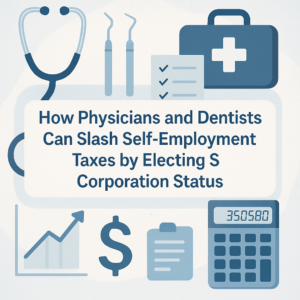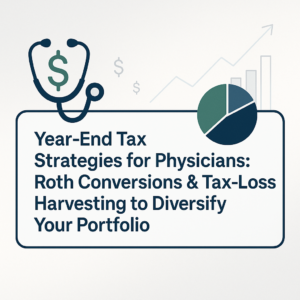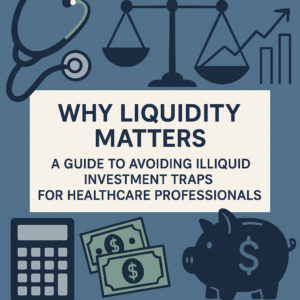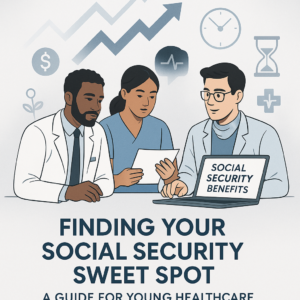Investing is not just about numbers and financial models; it’s deeply rooted in human psychology. One of the most challenging aspects of investing is managing the emotions that come with market fluctuations. Terms like “greed” and “fear” are often heard in financial circles, and they often drive many investors’ decisions, leading to cycles of buying (greed) and selling (fear).
For young healthcare workers like physicians, doctors, dentists, pharmacists, physical therapists, and psychologists, understanding these psychological dynamics can help in making informed and rational investment decisions. Healthcare professionals have strong salaries and growing incomes, offering significant opportunities for wealth accumulation. However, their careers can be demanding and unpredictable, making it hard to stay attentive to market shifts while keeping emotions in check.
Greed: The Driving Force of Bull Markets
Greed is a powerful motivator that can drive market bubbles and exuberant periods known as bull markets. During these times, investors, influenced by the prospects of high returns, often throw caution to the wind. Here’s how greed takes over:
Media Hype and Social Proof
During bull markets, the media often contributes to the hype, showcasing stories of astounding profits. These stories create a sense of urgency among investors who don’t want to miss out. Social proof amplifies this sentiment. If everyone around you is investing and making money, the fear of being left out can spur you into action, even if the fundamentals don’t justify the investments.
- GameStop Stock Surge: In early 2021, GameStop’s stock price surged due to a coordinated effort on social media platforms like Reddit. Small investors, driven by stories of massive gains, joined in, pushing the price to unprecedented highs.
- Cryptocurrency Booms: Similarly, the rise of cryptocurrencies like Bitcoin has been fueled by media hype and social proof. Stories of overnight millionaires attract new investors, driving prices even higher.
Market Euphoria
Euphoria is a state of overwhelming excitement that clouds judgment. It’s the moment when investors believe the market will keep going up indefinitely. Examples include the Dot-com bubble in the late 1990s and the housing bubble leading up to the 2008 financial crisis. During these periods, individual investors, institutions, and corporations made risky bets.
- Dot-com Bubble: Companies with little or no revenue were valued in the billions just because they were associated with the Internet. Greed took over rational investing, leading to massive investments in overvalued stocks. When the bubble burst, it wiped out trillions in market value.
- 2008 Real Estate Bubble: Easy credit and the belief that housing prices would always go up led to an unsustainable surge in housing investments. When the market crashed, it caused a global financial crisis.
The Transition from Greed to Fear
The transition from greed to fear is often abrupt and can be triggered by external factors such as policy changes, economic downturns, or catastrophic events. Here’s how it typically unfolds:
Economic Downturns
An economic downturn, triggered by falling GDP, rising unemployment, or declining industrial production, can quickly shift investor sentiment from greed to fear. The prospects of high returns are replaced by the fear of financial loss.
- COVID-19 Pandemic: The rapid onset of the pandemic in early 2020 led to an abrupt market decline. Healthcare stocks initially took a hit before recovering as the sector’s role in combating the pandemic became clear.
Policy Changes
Government policy changes, such as interest rate hikes or new regulations, can prompt investors to reevaluate their positions. For example, an interest rate hike might make borrowing more expensive, hurting high-growth companies that rely heavily on debt, causing a market downturn.
- Federal Reserve Rate Hikes: Historical data shows that when the Federal Reserve raises interest rates, it often leads to market corrections as investors reprice risk.
Catastrophic Events
Events like natural disasters, pandemics, or geopolitical tensions can act as catalysts for market crashes. The swift spread of COVID-19 in early 2020 triggered one of the quickest market declines in history as fear gripped investors worldwide.
- Geopolitical Tensions: Trade wars between the United States and China have also led to significant market volatility and shifts in investor sentiment.
Psychological Denial and Rationalization
When investments start to fail, denial and rationalization are common responses. Investors may hold onto losing positions too long, hoping the market will turn in their favor, leading to irrational decision-making.
- Stages of Grief Model: Investors may go through denial, anger, bargaining, depression, and acceptance, similar to the stages of grief, when faced with financial losses. Recognizing these stages can help in making more rational decisions.
Fear: The Catalyst of Panic Selling and Bear Markets
Fear is a natural human emotion designed to protect us, but in investing, it can lead to drastic decisions. Here’s how fear manifests in the markets:
Panic Selling
When fear sets in, rational thought often goes out the window. Panic selling occurs when investors, driven by the fear of losing their investments, try to sell off their assets en masse, leading to market crashes. The more people panic sell, the harder and faster the market falls, creating a vicious cycle.
- 2008 Financial Crisis: Panic selling during the 2008 financial crisis led to significant declines across global markets, wiping out trillions in value.
The Self-fulfilling Nature of Fear
Fear is particularly dangerous because it can be self-fulfilling. If enough investors believe that the market is going to crash, their collective panic selling can indeed cause the market to crash. This is why bear markets often have a momentum of their own.
Anatomy of a Market Crash
A market crash usually follows a period of intense fear and panic selling. It starts with small declines that gradually lead to bigger ones as investor confidence wanes. These crashes can wipe out significant portions of an investor’s portfolio if not managed properly.
The Role of Cognitive Biases
Cognitive biases are systematic patterns of deviation from norm or rationality in judgment, leading to illogical decision-making. Here are some key cognitive biases that impact investors:
Confirmation Bias
Confirmation bias occurs when investors favor information that confirms their preconceptions, ignoring evidence to the contrary. For example, during a bull market, an investor might only pay attention to news that supports a continued rise in stock prices, ignoring signs of a potential downturn.
Loss Aversion
Loss aversion is the tendency to prefer avoiding losses over acquiring equivalent gains. It is more painful to lose $100 than it is pleasurable to gain $100. This can lead to overly conservative investment behaviors, such as selling winning stocks too early or holding onto losing stocks too long.
Hindsight Bias
Hindsight bias is the inclination to see events as having been predictable after they have already occurred. This can lead to overconfidence, making investors believe they can predict future market movements based on past events, potentially leading to risky behaviors.
Overconfidence Bias
Overconfidence bias occurs when investors overestimate their ability to understand and predict market movements, often leading to risky investments and significant losses.
Herd Mentality
Herd mentality is the tendency to follow the crowd, believing that the majority’s actions are the correct ones. This can result in irrational investment decisions, especially during periods of market exuberance or panic.
Anchoring
Anchoring occurs when investors fixate on a particular piece of information, such as a stock’s initial price, and use it as a reference point for future decisions, even if other relevant information emerges.
Strategies to Recognize and Mitigate Cognitive Biases
Education is a powerful tool in recognizing and mitigating cognitive biases. Investors should seek information that challenges their views, diversify their portfolios to manage risk, and accept mistakes and learn from them. Professional financial advice can also help in maintaining a balanced perspective.
- Exercises: Keep an investment journal to track decisions and reasoning. Review periodically to identify patterns or biases.
- Tools: Use financial planning apps that offer unbiased analytics to guide investment decisions.
- Professional Advice: Consult with a financial advisor regularly to gain an objective perspective.
Investment Strategies to Combat Greed and Fear
Understanding and mitigating the impact of greed and fear on investment decisions is crucial. Here are some strategies to help combat these emotions:
Long-term Investment Horizon
Adopting a long-term investment horizon can help investors ride out short-term volatility driven by greed and fear. Healthcare professionals can benefit from this approach considering their typically steady income and high earning potential.
Diversification
Diversification involves spreading investments across different asset classes to reduce risk. A diversified portfolio means that losses in one area can be offset by gains in another, mitigating the impact of market cycles driven by greed and fear.
Asset Allocation
Asset allocation aims to balance risk and reward by adjusting the percentage of each asset in an investment portfolio according to the investor’s risk tolerance, goals, and investment timeline.
Disciplined Rebalancing
Rebalancing involves periodically buying or selling assets to maintain a desired level of asset allocation. It ensures that the investment portfolio remains aligned with the investor’s risk tolerance and financial goals, helping combat the emotional tendencies of greed and fear. Set a schedule (e.g., quarterly or annually) to review and rebalance the portfolio, ensuring it stays aligned with goals and risk tolerance.
Learning from Past Market Cycles
Historical market cycles offer valuable lessons that can inform future investment strategies. Here are some key takeaways from past market phenomena:
Historical Examples of Greed and Fear
- The Dot-com Bubble: During the late 1990s, tech stocks skyrocketed, driven by speculation that every internet company was destined for enormous success. The bubble burst in 2000, leading to significant losses.
- The 2008 Financial Crisis: Greed in the housing market, fueled by easy credit and speculative investments, led to a severe market crash when the bubble burst, resulting in a global financial downturn.
Lessons from Famous Investors
Renowned investors like Warren Buffett emphasize the importance of being fearful when others are greedy and greedy when others are fearful. Buffett’s strategy of value investing, focusing on intrinsic value rather than market sentiment, has yielded considerable success.
Investors like Ray Dalio advocate for balanced portfolios that can perform across various economic environments, while John Bogle emphasizes low-cost, long-term index investing.
Conclusion
Investing is as much about managing emotions as it is about financial acumen. The cycle of greed and fear, driven largely by psychological factors and cognitive biases, can significantly impact investment decisions. For young healthcare workers, understanding these psychological dynamics is crucial in making rational investment choices. By adopting long-term investment horizons, diversifying portfolios, rebalancing assets, and seeking professional financial advice, investors can better navigate the ups and downs of the market.
In summary, the importance of psychological awareness in investing cannot be overstated. Emotional discipline, combined with informed strategies and professional guidance, is the key to successful investing. Remember that the ultimate goal is to achieve financial well-being, providing security and peace of mind as you progress through your career in healthcare.






